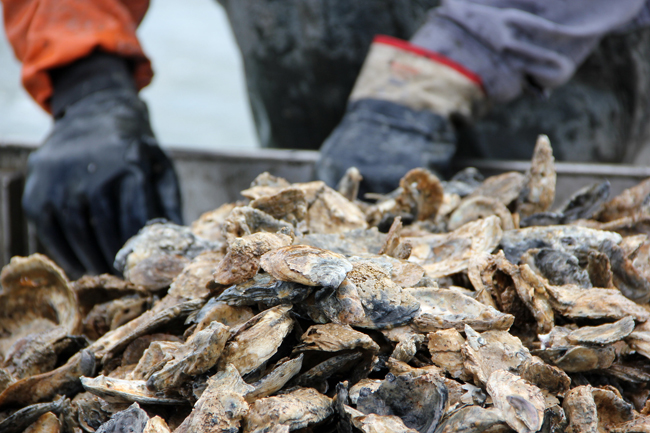
Larval oysters. Credit: Caroline Schwaner
— By Chris Gonzales, Freelance Science Writer, New York Sea Grant
Stony Brook, NY, May 6, 2022 - How do populations of organisms respond to stressful environments? What can these responses tell us about how a species will react to environmental change? An organism might disperse to a new region, shifting its range. It might acclimatize to its existing region. Or it might adapt.
A group of New York Sea Grant-funded scientists is using the eastern oyster, Crassostrea virginica, as a model species to measure the importance of rapid evolutionary responses. They compared patterns of gene expression in oysters from high-and low-salinity reefs from a single estuary, i.e., spatially distinct environments experienced by a large single population. (Even though oysters become cemented and stationary on a reef for most of their life, they begin life with a 2-3 week larval dispersal stage that keeps genetic variation well mixed within estuaries.)
Classical evolutionary theory predicts that local adaptation, which happens over many generations, cannot lead to genetic and trait differentiation at small spatial scales relative to dispersal distances. This experiment was designed to test the possibility that single annual cohorts of oysters are so abundant, and have so much genotypic diversity, that when they experience strong spatially heterogeneous natural selection it generates microgeographic differentiation in phenotypes like gene expression, low salinity tolerance or disease resistance.
They found eight times more gene expression response to experimental salinity variation in oysters from high-salinity reefs versus low-salinity reefs. Patterns of genomic variation in the study oysters suggested that stressful low salinities had caused natural selection on oysters in the low-salinity habitat prior to collection of adults, possibly truncating their gene expression responsiveness to experimental salinity exposures relative to oysters collected at high salinity. Follow-up research is analyzing genetic variation across the entire oyster genome to measure differential effects of natural selection on cohorts of oysters across the estuarine salinity gradient. Annual cohorts of oysters are indeed experiencing spatially distinct patterns of natural selection across microgeographic distances, and these short-term evolutionary changes across spatially and temporally varying environments may be maintaining overall higher levels of genetic variation. Ultimately, levels of genetic variation and evolutionary potential are important factors determining winners and losers among species that get pushed toward extinction by climate change.
Eierman, L. & Hare, M. (2016). Reef-Specific Patterns of Gene Expression Plasticity in Eastern Oysters (Crassostrea virginica). Journal of Heredity, 90–100. doi.org/10.1093/jhered/esv057

Oyster shells. Credit: Chesapeake Bay Program (Flickr)
More Info: New York Sea Grant
New York Sea Grant (NYSG), a cooperative program of Cornell University and the State University of New York (SUNY), is one of 34 university-based programs under the National Oceanic and Atmospheric Administration’s National Sea Grant College Program.
Since 1971, NYSG has represented a statewide network of integrated research, education and extension services promoting coastal community economic vitality, environmental sustainability and citizen awareness and understanding about the State’s marine and Great Lakes resources.
Through NYSG’s efforts, the combined talents of university scientists and extension specialists help develop and transfer science-based information to many coastal user groups—businesses and industries, federal, state and local government decision-makers and agency managers, educators, the media and the interested public.
The program maintains Great Lakes offices at Cornell University, University at Buffalo, SUNY Oswego and the Wayne County Cooperative Extension office in Newark. In the State's marine waters, NYSG has offices at Stony Brook University and Cornell Cooperative Extension of Nassau County on Long Island; at Brooklyn College, with New York City Department of Environmental Protection in Queens and at Cornell Cooperative Extension in NYC and Elmsford and Kingston in the Hudson Valley.
For updates on Sea Grant activities: www.nyseagrant.org has RSS, Facebook, Twitter, Instagram, and YouTube links. NYSG offers a free e-list sign up via www.nyseagrant.org/nycoastlines for its flagship publication, NY Coastlines/Currents, which is published quarterly.